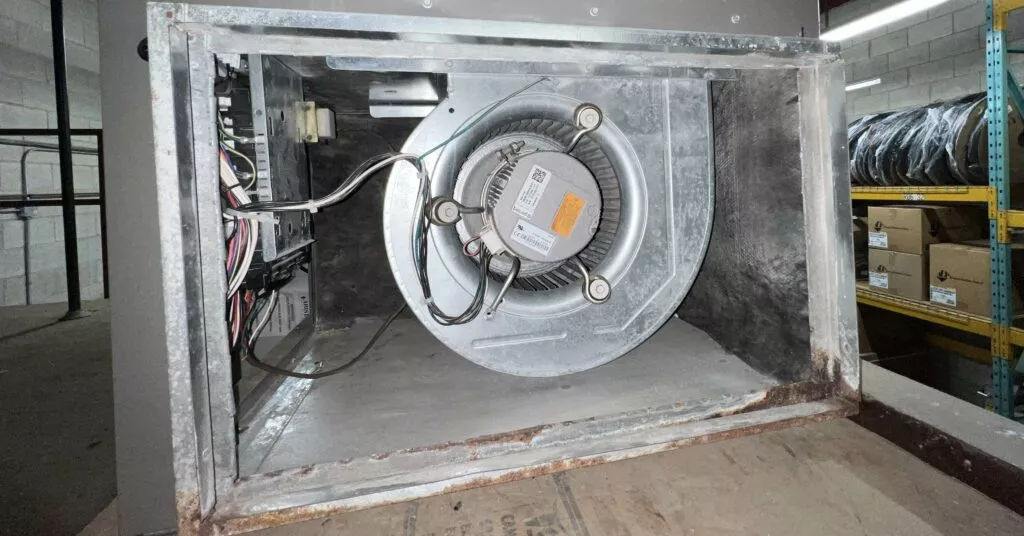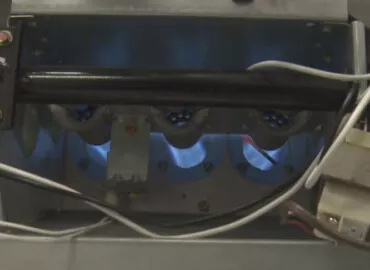6 Reasons Why Your Furnace Blower Keep Turning On and Off Repeatedly.
Have you ever noticed your furnace turning on and off more frequently than it should, failing to maintain the comfort level in your home? This phenomenon, known as furnace short cycling, is not just a nuisance; it can be a symptom of underlying issues that need immediate attention. Different from the standard heating cycles that typically last about 15 minutes, short cycling can last mere seconds or minutes and often doesn’t allow your home to reach the desired temperature. While a properly working furnace may cycle three to eight times per hour, anything beyond this range could signal a problem and potentially strain your system, leading to more significant issues down the line.
Understanding furnace short cycling is critical to ensuring your heating system operates efficiently and effectively. Excessive short cycling not only hampers your comfort but can also intensify wear and tear on your furnace, possibly culminating in costly repairs or premature replacements. In this article, we will delve into the common causes of erratic blower behavior, explore the critical role of the thermostat, identify airflow issues along with their solutions, and discern between when to call in a professional or when to apply a do-it-yourself fix. Moreover, you’ll learn about preventive measures and the importance of regular maintenance to keep your heating system functioning optimally. We aim to provide you with actionable insights and solutions, empowering you to address furnace short cycling confidently and effectively.
Understanding Furnace Operation
To fully grasp the intricacies of furnace short cycling, it’s vital to understand the basic operation of a central gas heating system, or furnace. Here’s a breakdown of how your furnace functions to keep you warm:
- Fuel Combustion: Your furnace operates by burning propane or natural gas in the furnace’s burner. This combustion process produces heat, which is the first step in warming your home. The efficiency and safety of this process are paramount, which is why it’s essential to ensure your furnace is properly maintained.
- Heat Transfer: Once generated, the heat is transferred to the air that is blown over the heat exchanger. This step is crucial as it’s where the actual warming of the air occurs before it’s circulated throughout your home.
- Air Distribution: The warmed air is then pushed by the furnace’s blower into the supply ductwork, which distributes the heat evenly across different rooms. This is where you might notice the symptoms of furnace short cycling if the system is turning on and off more frequently than normal.
Understanding the key components of your furnace can also help diagnose short cycling issues:
- Temperature Control: This component regulates the heating cycle to maintain the desired temperature in your home.
- Draft Induced Fan: Assists in safely venting exhaust gases out through the flue/chimney.
- Gas Burners: Where the fuel is ignited to produce heat.
- Ignition Switch: Responsible for initiating the combustion process.
- Heat Exchanger: A critical component where air is heated before distribution.
- Blower Fan: Circulates the heated air throughout your home.
- Flue/Chimney: Vents the combustion gases outside your home.
Furnaces are not one-size-fits-all; they come in different types, including:
- Non-condensing furnaces: Typically operate at lower efficiencies.
- Condensing Furnaces: Designed for higher efficiency with a secondary heat exchanger to extract more heat from the combustion gases.
- Modulating Gas Furnaces: Offer variable heating outputs for more precise temperature control.
The size of your furnace is a critical factor in its operation. An undersized furnace will struggle to heat your home, while an oversized one can lead to unnecessary energy consumption and wear. The heat capacity of furnaces is measured in British Thermal Units (BTUs), where one BTU is the heat required to raise the temperature of one pound of water by one degree Fahrenheit.
During a heating cycle, gas is supplied to the furnace, ignited in the burner, and used to warm the air in the heat exchanger. This warm air is then distributed throughout the home, providing the comfort you rely on during cold days.
If you’re experiencing a furnace turning on and off at an unusual rate, it’s a sign that something may be amiss with one or more of these components or processes. Identifying the cause of furnace short cycling is the first step in finding a solution and ensuring your system operates efficiently and effectively.
Common Causes for Erratic Blower Behavior
Erratic blower behavior in your furnace can be a source of frustration and discomfort. Understanding the common causes of this issue is the first step towards a solution. Here’s what might be causing your furnace to act up:
- Airflow Complications:
- Unclean Air Filters: A dirty air filter restricts airflow, causing the furnace to work harder and potentially overheat, leading to short cycling. Regularly checking and replacing your air filter can prevent this issue.
- Blocked Air Vents: Closed or obstructed air vents reduce the flow of air through your system, which can trigger the furnace to turn off prematurely.
- Dirty Blower Wheel: Accumulated dirt on the blower wheel can impede its function, disrupting the airflow and causing erratic behavior.
- Thermostat Troubles:
- Faulty Wiring: Wiring issues could lead to incorrect signals being sent to your furnace, causing it to turn on and off unexpectedly.
- Battery Problems: If your thermostat is battery-operated, low batteries might be the culprit behind inconsistent furnace cycles.
- Improper Location: A thermostat placed near a heat source or in direct sunlight can misread the actual room temperature, leading to short cycling.
- Component Concerns:
- Fire Sensor Issues: A dirty or rusted flame sensor may fail to detect the flame properly, causing the system to shut down for safety reasons.
- Blower Motor Malfunctions: Without proper airflow over the heat exchangers, the furnace may overheat and shut off to prevent damage.
- Flue Pipe Blockages: A damaged or blocked vent pipe can cause the furnace to overheat, triggering safety mechanisms that shut the system down.
- Oversized Furnace:
- An oversized furnace heats your home quickly but also shuts off soon after, leading to frequent cycles and increased energy usage. This can also result in uneven heat distribution throughout your home.
To tackle these issues, consider the following solutions:
- Ensure your air filter is clean and replace it if necessary, which is one of the simplest fixes for furnace short cycling.
- Inspect and clean your blower wheel to promote optimal airflow and prevent your furnace from turning on and off erratically.
- Check the batteries in your thermostat and replace them if needed. Also, make sure your thermostat is correctly located away from direct heat sources.
- If you suspect a faulty fan limit switch or a more complex issue, it’s best to seek professional assistance to ensure your furnace is repaired safely and effectively.
By addressing these common causes, you can help ensure your furnace runs smoothly, providing consistent warmth and comfort in your home.
The Role of the Thermostat
The thermostat’s role in preventing furnace short cycling cannot be overstated. As the command center of your HVAC system, it dictates when your heating or cooling system activates and deactivates, thus maintaining the desired temperature within your home. Here are some steps to ensure your thermostat functions correctly and avoids contributing to short cycling:
- Thermostat Settings: Adjust your thermostat settings to ensure they are aligned with your heating needs. An incorrect setting can lead to unnecessary short cycling and increased wear on your system.
- Battery Check: Perform regular maintenance, including timely battery replacements, to prevent power issues that can cause erratic behavior in your furnace.
- Thermostat Placement: Assess the placement of your thermostat. It should be located away from direct sunlight, drafts, doorways, windows, and any heat sources to avoid false temperature readings.
Thermostat problems, such as faulty wiring, an outdated interface, or incorrect placement, can lead to frequent on-and-off cycles of your furnace. To address these issues:
- Wiring Inspection: Check the thermostat’s wiring for any loose connections or signs of wear and tear. This can prevent miscommunication between the thermostat and your furnace.
- Thermostat Upgrade: Consider upgrading to a digital, programmable thermostat that offers more precise control over your heating and cooling schedules, potentially reducing your energy bills.
- Placement Review: Ensure your thermostat is placed in a location that accurately reflects the overall temperature of your home, away from any misleading heat sources.
To further prevent short cycling related to thermostat issues, you can:
- Follow the Manufacturer’s Instructions: Always refer to your thermostat’s manual for correct wiring and operation guidelines. This ensures that you are utilizing the device as intended for optimal performance.
- Regular Maintenance: Keep up with regular maintenance, including cleaning the thermostat to prevent dust from interfering with its sensors.
By ensuring your thermostat is working correctly and set at the right temperature, you can prevent short cycling and maintain a consistent and comfortable climate in your home. Remember, unusual noises, inefficient heating, and frequent cycling can be early warning signs of furnace problems, including thermostat issues. If you notice any of these signs, it may be time to troubleshoot your furnace and check for potential causes, including examining the thermostat settings and ensuring there are no airflow blockages.
Airflow Issues and Solutions
Ensuring your furnace operates smoothly and avoids the common issue of furnace short cycling requires a proactive approach to airflow management. Here are some solutions to address airflow issues that can lead to your furnace turning on and off more frequently than it should:
- Regular Maintenance:
- Start with the basics: regularly clean or replace your air filter to maintain unrestricted airflow. This simple step is often overlooked but is essential to prevent short cycling and ensure your system operates at peak efficiency.
- Check for air leaks in your ductwork, which can cause your furnace to work harder than necessary, leading to short cycling. Sealing these leaks can improve system efficiency and comfort.
- Inspect and clean your furnace’s components, including the blower fan, to ensure they are free of dust and debris. A clean system is a more efficient system.
- Optimizing Airflow:
- Keep all vents open and free of obstructions to guarantee adequate airflow throughout your home. Furniture, curtains, or rugs blocking vents can cause your furnace to overheat and shut off prematurely.
- Verify that the flue or vent pipe is clean and unobstructed. This is crucial for the safe and efficient operation of your furnace, as a clogged vent can lead to overheating and short cycling.
- Addressing System Size and Quality:
- If your furnace is oversized for your home, it may heat the space too quickly and shut off, resulting in short cycling. In this case, consulting an HVAC expert to assess whether you need a more appropriately sized unit is advisable.
- Consider upgrading to a variable speed or two-stage furnace. These advanced systems can better regulate airflow and temperature, providing a more consistent and comfortable indoor climate.
By implementing these strategies, you can help prevent your furnace from short cycling, which not only improves comfort but also extends the life of your heating system. Remember, regular maintenance is key, and when in doubt, it’s always best to seek the expertise of a professional who can provide a thorough inspection and tailor solutions to your specific needs. If you’ve noticed your furnace short cycling, taking action sooner rather than later can save you from the inconvenience and cost of more significant repairs down the line.
Faulty Components and Professional Assessment
When it comes to the health of your furnace, addressing faulty components is crucial in preventing and resolving furnace short cycling. Here are some critical steps and considerations:
- Professional Assessment:
- A faulty fan limit switch is a component that may fail and cause your furnace to short cycle. This switch regulates when the blower turns on and off based on the air temperature within the furnace, and if it’s not functioning correctly, professional assistance is often required to diagnose and repair the issue.
- Other critical components like the blower motor, flue, or flame sensor are intricate parts of your furnace that, when faulty, can result in short cycling. For these components, consulting with a professional is recommended for accurate diagnosis and resolution.
- Ignition and Gas Valve Inspection:
- Ignition problems can prevent your furnace from starting properly, leading to short cycling. Similarly, a malfunctioning gas valve can disrupt the flow of fuel, causing irregular operation. Regular maintenance and inspection of these parts can help prevent such issues.
- For persistent problems, it might be necessary to delve into potential issues with the ignition or pilot light, fuel lines, or the electronic ignition system. If you’re not familiar with these components, it’s best to call a professional for diagnosis and repair.
- Flame Sensor Maintenance:
- Regularly checking for and cleaning or replacing dirty or broken flame sensors is a proactive step in preventing short cycling. These sensors play a vital role in detecting whether the furnace’s flame is lit and, if not maintained, can lead to safety shut-offs that cause short cycling.
- Component Replacement:
- Faulty components can lead to heating issues, and early identification of these problems can prevent more costly repairs. Commonly replaced parts that may affect the cycle of your furnace include filters, igniters, thermostats, belts, and bearings. Keeping these components in check ensures the smooth operation of your furnace.
- Safety and Efficiency:
- Always prioritize safety when dealing with furnace repairs. Complex issues should be assessed by professionals who can provide proper troubleshooting and maintenance. This not only ensures efficient operation but also keeps your home warm and safe during the colder months.
By recognizing the signs of faulty components and seeking timely professional assistance, you can maintain an efficient and reliable heating system. Moreover, scheduling regular furnace servicing with a qualified technician can help identify and rectify potential problems early on, avoiding the inconvenience of unexpected breakdowns and ensuring your comfort throughout the season. Remember, a well-maintained furnace is less likely to experience short cycling, providing you with peace of mind and consistent warmth.
Preventative Measures and Regular Maintenance
To mitigate the issue of furnace short cycling and ensure your heating system’s longevity and efficiency, consider these preventative measures and regular maintenance tips:
- Regular Inspection and Maintenance: It’s crucial to have your furnace inspected and maintained regularly to catch and address small repairs before they escalate into major issues. This practice not only ensures your furnace operates efficiently but also extends its lifespan, saving you from unexpected and costly breakdowns in the future. Schedule an inspection with a trusted HVAC professional to keep your furnace in top condition and prevent minor repairs from spiraling into major concerns.
- DIY vs. Professional Help: While some furnace maintenance tasks can be performed on your own, such as changing air filters, it’s important to recognize when a problem is beyond your skill set. DIY repairs can be cost-effective, but without the right skills, they can lead to more significant issues. If you’re unsure about a repair, it’s always safer and potentially more cost-effective in the long run to seek professional help.
- Furnace Sizing and Replacement: An oversized furnace can cause frequent on/off cycles due to rapid heating, which doesn’t allow for even temperature distribution. If your furnace is not properly sized for your home, it may be necessary to replace it with a system that is correctly sized. A properly sized furnace can prevent short cycling and enhance the overall efficiency of your heating system.
- Annual Maintenance and Ignition Issues: Prioritize annual maintenance to address any ignition or gas supply issues promptly. Regular check-ups can identify potential problems early on, preventing short cycling and ensuring safe operation. A well-maintained furnace is less likely to experience issues and can offer consistent warmth and efficiency throughout its use.
- Home Insulation: Proper home insulation is key to maintaining consistent temperatures and preventing your furnace from short cycling. Ensure your home is well-insulated to keep the warm air inside, reducing the workload on your furnace and promoting more stable operation.
- Homeowner’s Maintenance Checklist:
- Change air filters regularly to maintain good airflow and prevent overheating.
- Check and replace thermostat batteries to ensure accurate temperature readings and consistent furnace operation.
- Keep vents clear of obstructions to allow for proper air distribution.
- Schedule a professional inspection to address any blower problems or other complex issues.
- Verify that your furnace is properly sized for your home to avoid short cycling due to an oversized unit.
- Costs of Maintenance: While regular maintenance incurs a modest fee, it is a worthwhile investment compared to the costs associated with part replacements and more extensive repairs. Regular upkeep not only prevents costly repairs but also ensures the safe and efficient operation of your furnace, contributing to lower energy bills and a comfortable home environment.
Remember, a proactive approach to furnace maintenance is the best way to avoid furnace short cycling and keep your home comfortably heated. Regular care and timely professional inspections can save you money and provide peace of mind.
Conclusion
Throughout this article, we’ve explored the various facets of furnace short cycling, highlighting its potential causes and the significant impact it can have on both your comfort and your heating system’s efficiency. From the critical role of thermostats to the importance of regular maintenance and professional assessments, we’ve underscored the importance of being vigilant and proactive in managing and preventing short cycling. By understanding the causes and implementing the suggested solutions, homeowners can ensure that their furnaces operate reliably and efficiently, providing uninterrupted warmth when it’s needed most.
As we conclude, it is essential to remember that the health of your furnace is paramount for maintaining a comfortable and energy-efficient home. Taking the steps to regularly maintain and address issues with your heating system can lead to long-term savings and avoid the distress of unforeseen breakdowns. For continued support and expert guidance on maintaining the ideal home environment, do not hesitate to reach out to our team of professionals. With their expertise, your furnace’s short cycling issues can be a thing of the past, ensuring a cozy winters season after season.
FAQ
Why does my furnace blower fan keep turning on and off?
Your furnace blower fan may repeatedly cycle due to a clogged air filter, a malfunctioning thermostat, inadequate airflow, or issues with the furnace's limit switch. Each of these issues can disrupt the blower's operation.
Why does my blower motor keep cutting out?
A blower motor can cut out because of electrical problems, overheating, or worn-out components. It may also be due to a malfunctioning capacitor or issues with the motor's bearings.
Why does my furnace blower motor work sometimes?
Intermittent blower motor operation can result from loose wiring, a faulty control board, or a damaged motor. Insufficient maintenance or worn components may also lead to sporadic functioning.
Can a thermostat cause short cycling?
Yes, a malfunctioning or improperly configured thermostat can cause short cycling. If the thermostat is not calibrated correctly, it may signal the furnace to turn on and off too frequently.
How do you know if the blower motor is bad in the furnace?
Signs of a bad blower motor include reduced airflow, unusual noises, or the motor not starting at all. If you suspect a faulty blower motor, consult an HVAC technician for a thorough inspection and potential replacement.
How do you fix HVAC short cycling?
Fixing HVAC short cycling may involve addressing issues like a clogged filter, thermostat calibration, or problems with the limit switch. It's advisable to consult a professional technician for accurate diagnosis and repair.
What to do if the furnace fan keeps running?
If your furnace fan continuously runs, it may be due to a thermostat issue, a malfunctioning limit switch, or problems with the fan control. Consult an HVAC technician to diagnose and resolve the problem.
How long should the furnace blower run?
The ideal duration for the furnace blower to run depends on various factors, including the system's design and your heating needs. On average, a blower should run for around 15-20 minutes per cycle to ensure efficient heating and proper air circulation.




